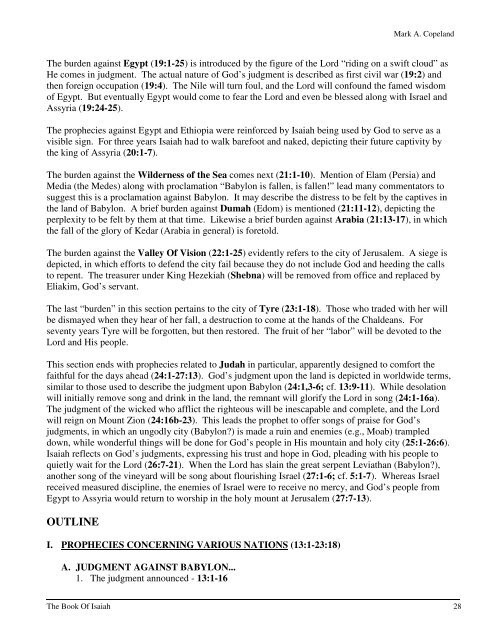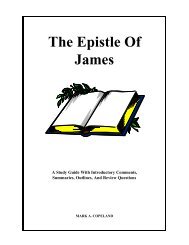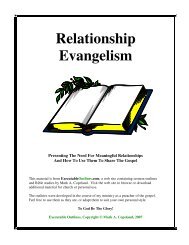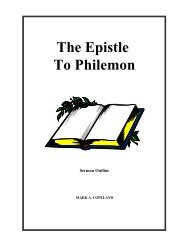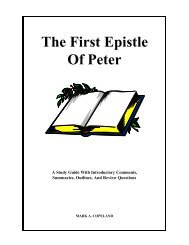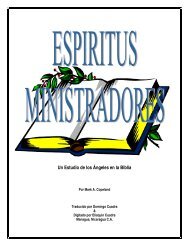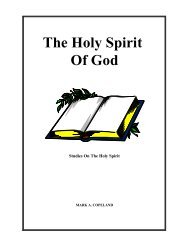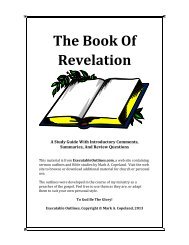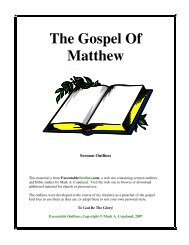The Book Of Isaiah - Executable Outlines
The Book Of Isaiah - Executable Outlines
The Book Of Isaiah - Executable Outlines
- No tags were found...
Create successful ePaper yourself
Turn your PDF publications into a flip-book with our unique Google optimized e-Paper software.
Mark A. Copeland<strong>The</strong> burden against Egypt (19:1-25) is introduced by the figure of the Lord “riding on a swift cloud” asHe comes in judgment. <strong>The</strong> actual nature of God’s judgment is described as first civil war (19:2) andthen foreign occupation (19:4). <strong>The</strong> Nile will turn foul, and the Lord will confound the famed wisdomof Egypt. But eventually Egypt would come to fear the Lord and even be blessed along with Israel andAssyria (19:24-25).<strong>The</strong> prophecies against Egypt and Ethiopia were reinforced by <strong>Isaiah</strong> being used by God to serve as avisible sign. For three years <strong>Isaiah</strong> had to walk barefoot and naked, depicting their future captivity bythe king of Assyria (20:1-7).<strong>The</strong> burden against the Wilderness of the Sea comes next (21:1-10). Mention of Elam (Persia) andMedia (the Medes) along with proclamation “Babylon is fallen, is fallen!” lead many commentators tosuggest this is a proclamation against Babylon. It may describe the distress to be felt by the captives inthe land of Babylon. A brief burden against Dumah (Edom) is mentioned (21:11-12), depicting theperplexity to be felt by them at that time. Likewise a brief burden against Arabia (21:13-17), in whichthe fall of the glory of Kedar (Arabia in general) is foretold.<strong>The</strong> burden against the Valley <strong>Of</strong> Vision (22:1-25) evidently refers to the city of Jerusalem. A siege isdepicted, in which efforts to defend the city fail because they do not include God and heeding the callsto repent. <strong>The</strong> treasurer under King Hezekiah (Shebna) will be removed from office and replaced byEliakim, God’s servant.<strong>The</strong> last “burden” in this section pertains to the city of Tyre (23:1-18). Those who traded with her willbe dismayed when they hear of her fall, a destruction to come at the hands of the Chaldeans. Forseventy years Tyre will be forgotten, but then restored. <strong>The</strong> fruit of her “labor” will be devoted to theLord and His people.This section ends with prophecies related to Judah in particular, apparently designed to comfort thefaithful for the days ahead (24:1-27:13). God’s judgment upon the land is depicted in worldwide terms,similar to those used to describe the judgment upon Babylon (24:1,3-6; cf. 13:9-11). While desolationwill initially remove song and drink in the land, the remnant will glorify the Lord in song (24:1-16a).<strong>The</strong> judgment of the wicked who afflict the righteous will be inescapable and complete, and the Lordwill reign on Mount Zion (24:16b-23). This leads the prophet to offer songs of praise for God’sjudgments, in which an ungodly city (Babylon?) is made a ruin and enemies (e.g., Moab) trampleddown, while wonderful things will be done for God’s people in His mountain and holy city (25:1-26:6).<strong>Isaiah</strong> reflects on God’s judgments, expressing his trust and hope in God, pleading with his people toquietly wait for the Lord (26:7-21). When the Lord has slain the great serpent Leviathan (Babylon?),another song of the vineyard will be song about flourishing Israel (27:1-6; cf. 5:1-7). Whereas Israelreceived measured discipline, the enemies of Israel were to receive no mercy, and God’s people fromEgypt to Assyria would return to worship in the holy mount at Jerusalem (27:7-13).OUTLINEI. PROPHECIES CONCERNING VARIOUS NATIONS (13:1-23:18)A. JUDGMENT AGAINST BABYLON...1. <strong>The</strong> judgment announced - 13:1-16<strong>The</strong> <strong>Book</strong> <strong>Of</strong> <strong>Isaiah</strong> 28


